
15 minute read
TRAVEL
Gorgeous Guiyang Exploring Guizhou’s Capital, p24
SIMON COCKERELL General Manager at Koryo Tours Interview by Matthew Bossons
Advertisement
In an industry dominated by bigbrand hotels, luxurious cruise tours and preorganized, cookie-cutter vacations to tropical beaches, the team at Koryo Tours are rebels. These renegades of tourism are most famous for their various tours to the DPRK, or North Korea, but the company offers so much more, including trips to Central Asia, Russia and Bhutan. To learn more about the company’s off-the-beaten-track tours, we caught up with Simon Cockerell, the general manager at Beijing-based Koryo Tours.
Koryo Tours is well-known for its DPRK adventures, but your team offers tours to other nations as well. When did the company start branching out? In 2004, Turkmenistan Airlines opened flights between Ashgabat and Beijing. I was fortunate enough to be offered a ticket on their first flight and made a recce visit myself at that time. I found the country to be fascinating, friendly and deeply intriguing – just the kind of place we like to visit. I went again in early 2005 and then we started running group tours. Since then, we have consulted on various other projects for media, guidebooks and so on.
We continue to operate tours to Turkmenistan and have also added Tajikistan, Mongolia, parts of Russia, Kazakhstan and now Bhutan to the list. The reason for this expansion is basically to offer the kinds of people who travel with us an experience that they would not otherwise be able to arrange for themselves.
Of the Central Asia nations Koryo visits, which would you recommend to some one unfamiliar with the region? The ‘easiest’ to visit would be Kazakhstan. It’s the most developed, has cities which are easy to get around, a cosmopolitan society and isn’t particularly hostile or dif ficult for first-time visitors. What we offer there is of course the highlights plus trips to some complicated and complex parts of the country, such as the nuclear weap ons testing area of the Semipalatinsk Polygon, so that visitors get a complete range of experiences.
For me, though, my first choice would be Turkmenistan – despite the well-docu mented complications of traveling there. It is the most difficult one and the most different to the others (only by a nose, though, Tajikistan is also a very distinct place). The travel experience there com bines history, the current idiosyncratic system and its architectural and social manifestations, as well as very welcoming people.
I know this isn’t a conclusive answer but I would say that if someone has the time they should travel through all Central Asia.
The Gates of Hell in Turkmenistan is a fascinating spot. What can tourists ex pect from this destination? The site is a giant pit formed by a gas ex traction industrial accident decades ago. Leaking gas was ignited by locals to burn it off and yet here we are in 2020 and it is still burning. The moniker ‘Gates of Hell’ is one most people in Turkmenistan don’t bother with, but it is still accurate.
We drive there, pitch camp and our local drivers cook up a superb desert feast of shashlik and various vegetables. Visitors can go down to the crater, pose for photos, climb a nearby hill that offers a view into the heart of the inferno – made up of thousands of smaller flames, plus a giant central spout of fire – and simply be hypnotized by the experience. Birds often wheel overhead on the updraft and insects are called to the pit by some force that compels them to walk into the flames; it is simply an otherworldly place, and for the mild discomfort of sleeping one night in a tent with no toilet facilities nearby you get to experience something that will stay with you forever.
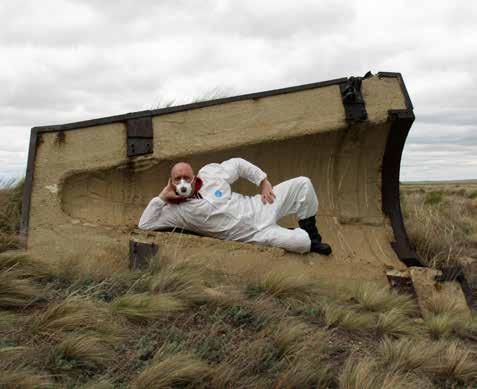
Whereabouts in the mighty Russian Federation does Koryo currently offer tours? I have been to Russia something like 30 times and I strongly recommend it. It’s simply a unique country in so many ways. The places we operate tours to are remote and complicated parts that are perhaps not ideal for first-time visitors to Russia. If you join a tour with us and you haven’t been to Russia before, then stop in Moscow and St. Petersburg on the way for a touch of normality first.
We do trips to Norilsk in the Arctic circle, a closed-city (meaning foreigners aren’t allowed, we have a way in though) that was originally a gulag mining settle ment.
The other place we take tourists is to Magadan in the North of Russia’s Far East. Known primarily for its dark history as the worst of the gulag regions during the USSR’s darkest period, it has a stun ning natural landscape punctuated by abandoned cities and towns. You’ll find resilience, humor (both dark and light), history (mostly dark) and vast distances of tough ground to cover.
ITCHYFEET
ROOM SERVICE
Wuhan Hotels Call for Aid
Hotels in Wuhan called for government assistance last month as the local hospi tality industry reels from the impact of a monthslong lockdown. According to a report by SupChina, hundreds of hotels in Hubei’s capital signed an open letter to the local government to request financial assistance after providing free lodging to healthcare workers battling the city’s COVID-19 outbreak.
“Even though we exhausted most of our resources during the pandemic, we squeezed every penny out of our pockets to contribute to the battle against the outbreak,” read the letter, according to SupChina. “Now we are anxiously waiting for assistance from the government.”
Assistance methods listed in the letter include financial aid, loans, rent relief and vouchers to help stimulate consumption in the tourism industry.
Estimates from Wuhan’s Hotel Apartment Volunteer Union suggest that hospitality venues in the city collectively provided a staggering 200,000 nights of free accommodation for medical workers. The value of this contribution? More than RMB20 million.
MILE HIGH Reduced Routes

At the end of March, the Civil Aviation Administration of China (CAAC) announced that China would be drastically cut ting passenger flights in an effort to contain a potential ‘second wave’ of the coronavirus pandemic. As the number of confirmed cases continued to rise outside of China, CAAC or dered Chinese airlines to operate only one route per country, once a week. Three of the ‘big four’ airlines announced their adjusted routes via Weibo, which were in effect until the end of April.

HOT SPOT

Siem Reap
The city of Siem Reap is home to what is unquestionably Cambodia’s most spectacular tourist attraction, Angkor Wat. A UNESCO World Heritage Site and the world’s largest religious monument, Angkor Wat and its surrounding temples will make any visitor feel like they’ve been dropped smack-dab in the middle of an Indiana Jones adventure (if you manage to avoid the crowds, anyway). Angkor Wat was originally created as a place of worship for Hindus, although it became a Buddhist holy site after it was sacked by the Cham people in 1177 and King Jayavarman VII built nearby Angkor Thom. While the architecturally splendid temples in Siem Reap get most of the attention, there is much more to the city: Bustling markets, numerous museums and the nearby floating villages all make a visit to Siem Reap worthwhile. After a long day of explora tion, be sure to snag a bevvy along the city’s famed Bar Street – a great place to connect with other travelers and the jackass backpacker crowd!
HOSPITALITY HIGHLIGHT
Songtsam Linka Shangri-La
Hidden in the scenic valleys of Yunnan’s Shangri-la, between Tibetan villages and Himalayan barley fields, Songtsam Linka Shangri-La faces the back of Songzanlin Monastery. It’s an ideal escape for weary city dwellers and those looking to unplug from the constant barrage of COVID-19 news, with Tibetan-style rooms, topnotch dining facilities, a spa and other modern amenities housed in hand-built Tibetan Kham-styled stone buildings. Each of the structures is arranged in front of a hillside amongst flowers and trees and sur rounded by snow-capped mountains.
Monks, local people and horses regularly pass through the pine for est beside the hotel, offering a taste of authentic village life in one of China’s most stunning locations.
In addition to Songtsam Linka Shangri-La, the Songtsam brand also offers other luxury boutique hotel experiences and tailor-made tour packages in Tibet and other locations in Yunnan province.
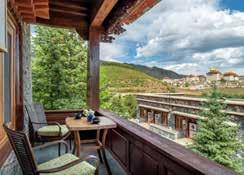

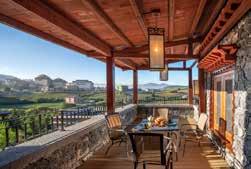

> For further inquiries, we encourage readers to reach out to Songtsam ’ s director of international marketing, Justin Culkin, via email at justin@songtsam.com

Looking for more expert guides to China’s biggest cities and hottest des tinations? Then pick up our Explore China travel guide, which offers insider tips, detailed city guides and awesome day trips. You can purchase your copy today by messaging ‘Explore China’ to our of ficial WeChat account (QR code on the cover of this magazine).
GUIYANG
Located in the heart of beautiful Guizhou, Guiyang is the province’s capital city and home to well over 4 million people.
An expanse of urban sprawl set amongst stunning karst peaks, the city is the main jumping-off point for visitors look ing to explore the wonders of Guizhou, which include stunning natural vistas, enchanting minority cultures and even the world’s largest filled-aperture radio tel escope.
Situated in the loving embrace of the Nanming River, Guiyang is a plateau city that sits over 1,000 meters above sea level. The climate is considered subtropical.
Guiyang is host to some incredible tour ist attractions. Jiaxiu Pavilion was built during the Ming Dynasty and is located along the banks of the river. A short stroll away, you can check out the skyscrapers and modern architecture that help give Guiyang its hallmark ‘East meets West’ feel.
Guizhou is home to a vibrant array of peoples and cultures, including 23 different minority groups, and as the provincial capi tal, Guiyang is a great place to experience this rich cultural heritage. Hints of Miao culture can be seen across the city in tourist shops and restaurants, including examples of their colorful clothing and elaborate headdresses.
Guiyang is known to many as the Data Valley of China, due to its new economic and technological zones as well as its role as host of the Big Data Expo, which attracts major tech players such as Huawei and Alibaba. The city was also one of the first to launch 5G bus routes and is one of China’s 5G pilot cities.
The natural areas surrounding the city are famous for their karst peaks and for est parks, and authorities in Guiyang are hoping to protect green spaces and save the local ecology from the dangers of fast modernization. How? By using technology, of course. Local authorities have been using cloud tech to track changes in the forest en vironment and prevent forest fires – making it one of the few places in China where na ture meets technology and wins.
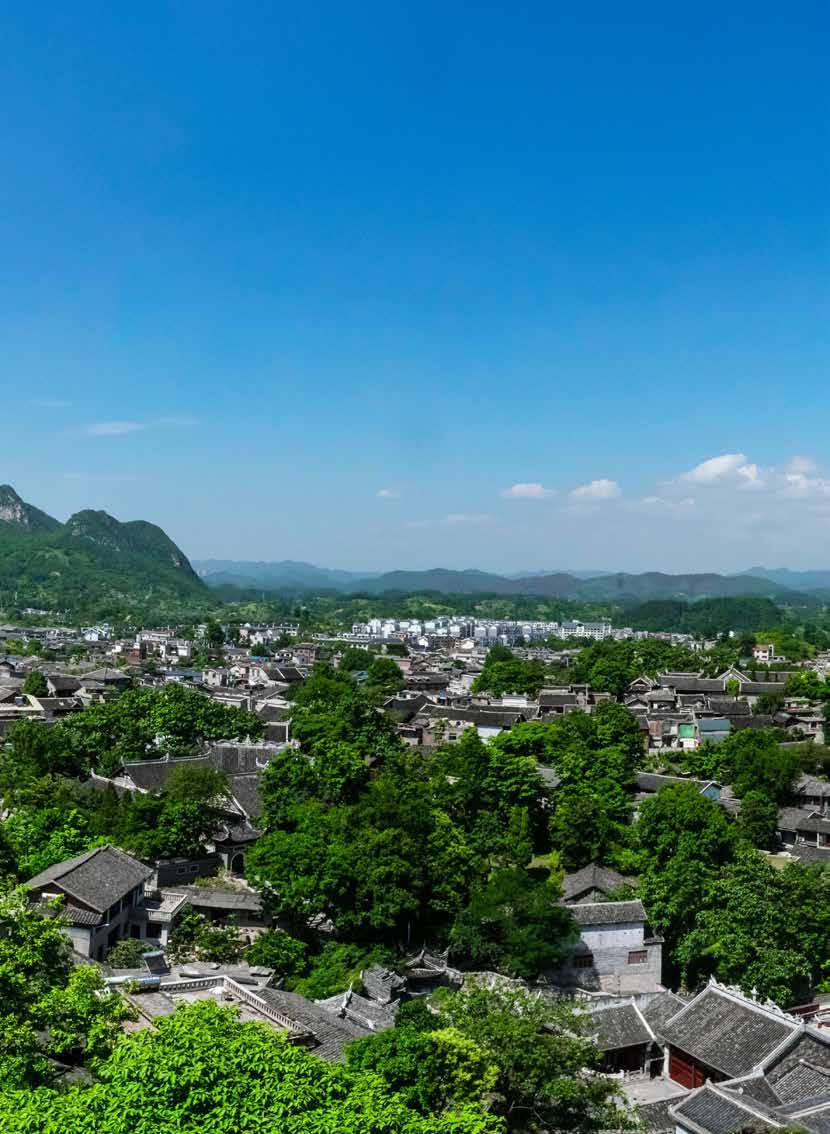

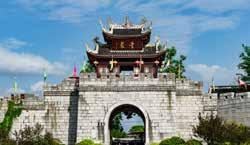
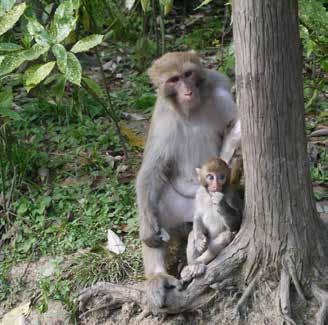
The Nanming River coils through Guiyang’s downtown, spanned by Floating Jade Bridge, where you can find Jiaxiu Pavilion. Initially built in the Ming Dynasty, the three-story tower hosts a famous cou plet by Liu Yushan, as well as calligraphy and engravings. The tower can easily be enjoyed in under an hour, and is lit beautifully in the evening. On the south side of the river, find gardens with tea shops, or pop into one of the many coffee shops on the north side to enjoy views of the tower.
Qianling Park
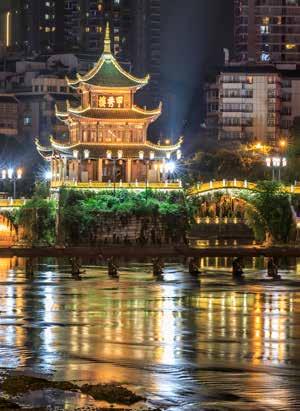
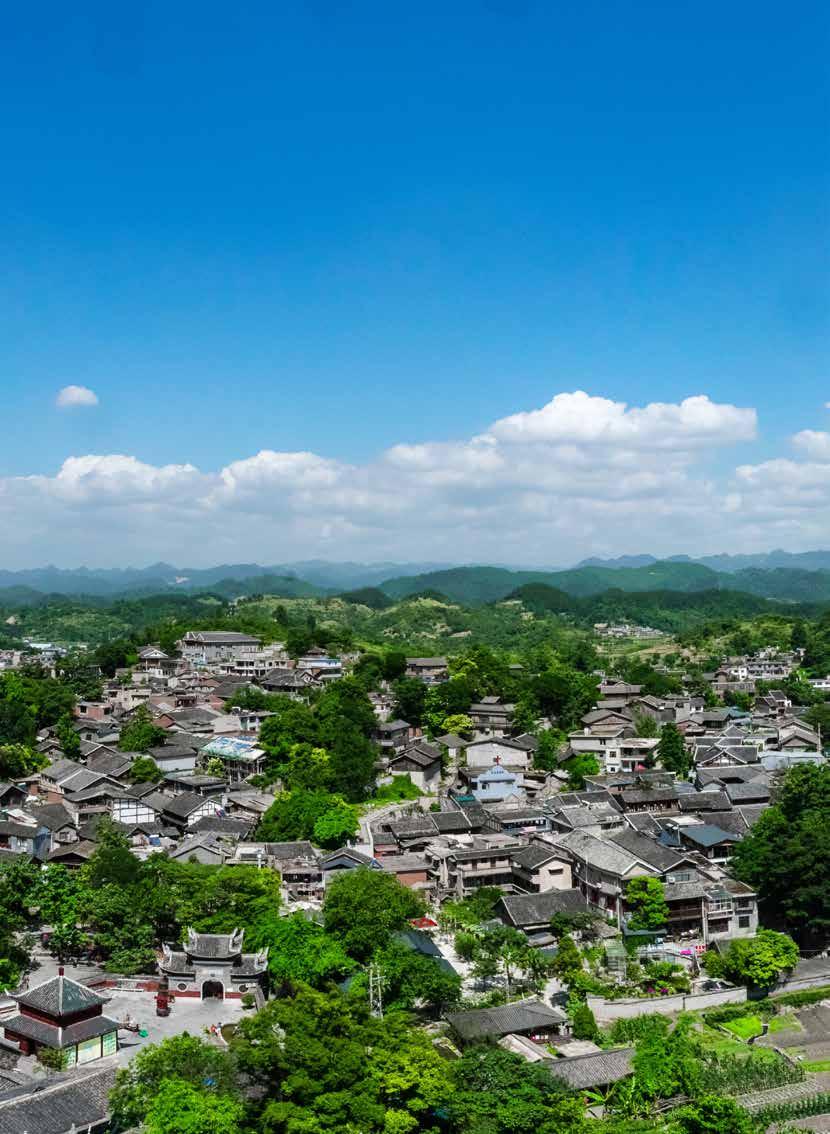
Over 400 hectares of forest cover Qianling Mountain, in the northern part of the city’s downtown. The park is especially noteworthy for the hundreds of wild ma caques that make their home there. Take the cable car to the summit to enjoy a view of the city and a leisurely stroll through the forested mountain paths. The park is also home to Hongfu Temple, a 17th century religious site with peaceful pools, murals and carved Buddhas. At the exit to the temple, people gather around a large and colorful carved stone wall with a Buddha at its center. According to local superstition, it’s good luck to walk across the small square with your eyes closed to touch the belly of the Buddha. Walking down the back of the mountain will take you to Qianling Lake, where there are boat rentals, and the tunnel to return to the front of the mountain.
Qingyan Ancient Town

Built in the Ming Dynasty, Qingyan is a historical fort town 29 kilometers south of Guiyang. People flock here year-round to enjoy the stone architecture, climb the city wall and sample local delicacies. The town is known for its pork trot ters and rice wine, which can be tasted while wan dering the narrow stone streets. The old town is full of winding side alleys that lead to Buddhist and Taoist temples, a palace, peaceful gardens, pavilions and caves. Shops and hawkers fill the main streets and sell tourist tat alongside locally-dyed indigo garments, silver jewelry and traditional foods.
A visit to Guiyang isn’t complete without stopping to see one of its many small night markets. Shanxi Lu is both central and long-stand ing. During the day, it looks just like any other street, but as night falls, vendors begin to line the sidewalks. Find spicy street bar becue, rice noodles in sour soup or with bowls of steamed clams and barbecued fish sizzling on a bed of oily chilies. After you’ve gotten your fill, look behind the food stalls to discover the most concentrated bar scene in town. Bars line Shanxi Lu on both sides, and turning right at the top of Shanxi Lu will take you the city’s most notorious bar street, Qianling Dong Lu.

Tufeng Bean Hot Pot
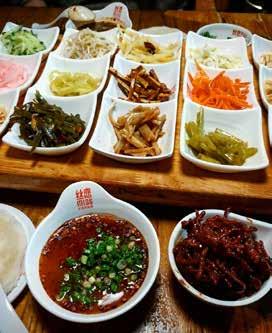

Serving up one of Guiyang’s best kept secrets, Tufeng’s smoked pork and bean hot pot broth is the thickest and most flavorful you’ll find in the city. An order of both smoked pork ( la rou) and deep-fried fatty pork (su rou) are highly recommended. Don’t forget to ladle some of the broth into the chili dip to make the perfect dipping sauce. As the meal goes on, the broth boils down into a thick, satisfying stew that you can pour over your rice. > 67 Qianling Dong Lu, Yunyan District 云岩区黔灵东路 67 号土风豆米火锅 (86 851 8677 1646)
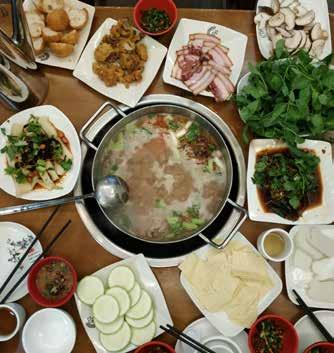
Siwawa (Silk Doll)
Silk babies can be found all over Guiyang, but people go to Siwawa (丝娃娃) for the quality sour soup and the good variety of Guiyang’s tradition al side dishes. When you order siwawa, you can refill your vegetable tray as many times as you like, so don’t hesitate to stuff your rice bundles to the max. Also, don’t miss out on the grilled pork belly or the barbecued eggplant. Lines can be long, so showing up a bit before or after stand ard meal times is recommended. > Various locations
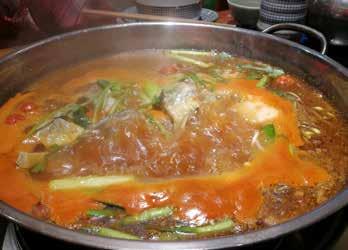
Kempinski Hotel Guiyang

The Kempinski Hotel Guiyang is a luxury accomodation located in the city center. This extravagant hotel boasts high-quality furnishings in each and every room, and hosts a beauti ful pool, fitness facilities and a spa. Due to the fact the Kempinski Hotel Guiyang is located in one of the tallest buildings in the city, the hotel offers fantastic views. As a bonus, fans of hearty German sausages and beer will love dining at the hotel’s Paulaner Brahaus. > 68 Huguo Lu, Nanming District 南明区护国路 68 号贵阳凯宾斯基大酒店 (86 851 8599 9999)
Lao Kaili Sour Fish Hot Pot
Known for their lively serving staff, fresh catfish and top-quality sour soup, Lao Kaili is a distinctly Guizhou experience. After ordering your hot pot and side dishes, you’ll be escorted to the aquariums to select your ideal fish. Served in a sour soup heavily accented with lemony Litsea oil, and complemented by a fiery dipping sauce, it’ll have your taste buds in overdrive. As a special treat, order a bottle of Miao-style rice wine ( mijiu) and the servers will sing to your table, tease you with fish-laden chopsticks and pour wine into your mouth from hollowed bulls’ horns. > 12 Shengfu Lu, Yunyan District 云岩区省府路 12 号老凯里酸汤鱼 (86 851 8584 3665)
Poly Hotspring Guiyang Hotel


The Poly Hotspring Guiyang Hotel is a beautiful hot spring resort. While it’s located a tad far from the city center – in Guiyang’s Wudang district, the scenic location is actually a major plus due to its natural hot springs. This hotel features spacious, lush rooms overlooking the surrounding forest, as well as elegantly designed common areas. For those that like to let loose after dark, the Poly Hotspring Guiyang Hotel has its own nightclub with live DJ performances. > 88 Shunhai Zhong Lu, Wudang District 乌当区顺海中 路 88 号保利国际温泉酒店 (86 851 8632 8888)




